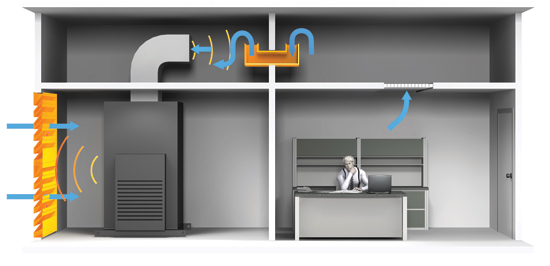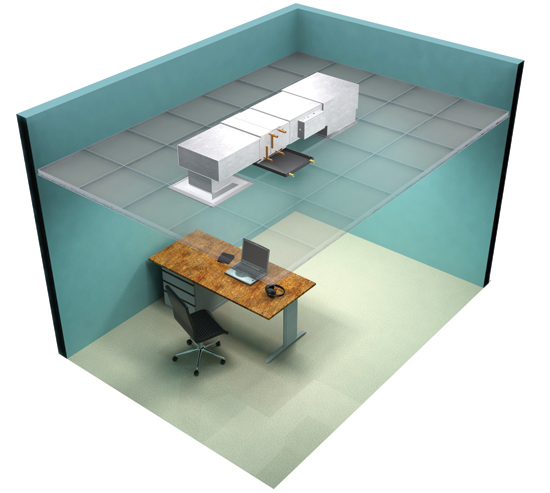Silence Is Golden
Air Transfer Silencers
Air transfer silencers can provide additional noise reduction to ensure that overall partition assemblies provide adequate noise isolation or speech privacy. For example, two adjacent rooms separated by a non-full height wall can be negatively impacted by noise flanking through the common ceiling plenum. As depicted in the accompanying illustration, this noise path can be reduced by using air transfer silencers at return grilles with the added benefit of reducing visibility into the plenum space. Projects often utilize non-full height walls between private spaces as a way to reduce cost. Unfortunately, if the resulting flanking path is not properly addressed, the relevant private space's effectiveness is also reduced.
Another common condition is when a full height wall (floor to deck) requires transfer air between spaces, but must maintain a specific STC rating. Mechanical room partitions, for example, are often designed to have a minimum STC-50 rating, but often also require penetrations for return air. One method for achieving both return air transfer and noise isolation requirements is to use a cross talk silencer, as depicted in the accompanying illustration. This product has lab-tested performance and can be sized appropriately to satisfy project design requirements.

Images courtesy of Price Industries
Noise and light transmission are additional issues that are often overlooked during the design process. By addressing both of these issues, air transfer silencers allow for more flexible space layouts and mechanical equipment placement. They also can result in significant construction cost savings because of their simplified installation. Lined return boots are often recommended, but they have several drawbacks. For one, lined return boots are usually field fabricated with no reliable performance data. They also require additional labor due to support requirements and their height often limits installation especially in crowded or shallow plenum conditions. An air transfer silencer on the other hand can be installed directly below mechanical equipment in addition to having lab performance and minimal labor costs.

Noise and light flanking reduction using an air transfer silencer
It's important to clarify that air transfer silencers do not provide the same amount of noise reduction as HVAC-duct silencers. Rather, air transfer silencers allow for the overall STC or CAC (Ceiling Attenuation Class) to be preserved. Most ceiling tile manufacturers provide CAC ratings for suspended ceiling systems. CAC measures the noise reduction between two adjacent rooms by accounting for the sound path through the ceiling and common overhead plenum. The purpose of air transfer silencers is to ensure that any air transfer openings are not noise flanking paths—this is often the weak link that reduces noise isolation performance. This noise reduction is also relevant for air moving equipment radiated noise, such as fan coils, terminals, and exhaust fans. Because air transfer silencers provide more noise reduction than typical ceiling tile, they eliminate any noise flanking path that would otherwise create a hot spot in the occupied space directly below.
Acoustic Louvers
Acoustic louvers provide another method for reducing noise transmission in applications with limited space. Available in depths between 6 inches and 12 inches, acoustic louvers provide reasonable lab-rated noise attenuation while allowing for air flow between spaces, such as mechanical rooms and the outdoors. Acoustic louvers can be designed to satisfy façade aesthetic requirements including size, color, and material. The main variable to consider is air flow. Unlike a typical architectural louver that has around 45 to 50 percent free open area, acoustic louvers have around 25 to 30 percent free open area and, as such, have reduced air flow capacity. Proper coordination with the mechanical engineer typically allows for the inclusion of acoustic louvers and in many cases can free up additional mechanical room space because of their compact design.

Acoustic louvers reduce noise transmission while satisfying air flow and limited space requirements.










